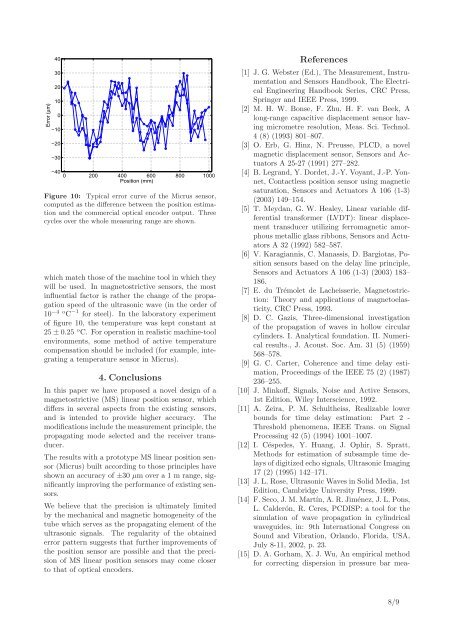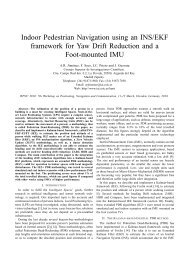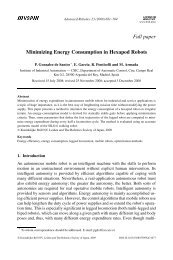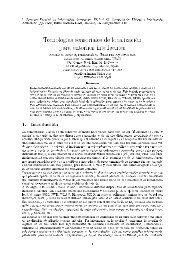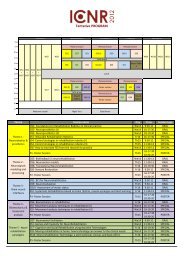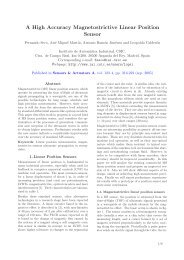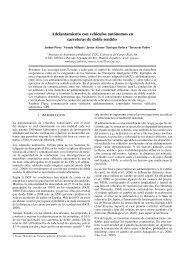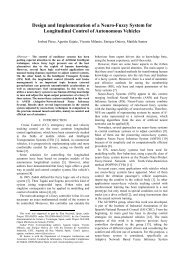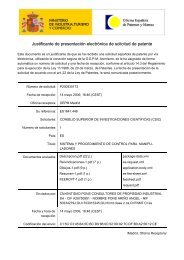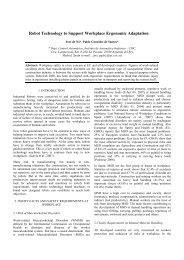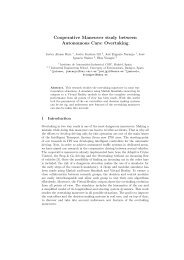A High Accuracy Magnetostrictive Linear Position Sensor
A High Accuracy Magnetostrictive Linear Position Sensor
A High Accuracy Magnetostrictive Linear Position Sensor
Create successful ePaper yourself
Turn your PDF publications into a flip-book with our unique Google optimized e-Paper software.
Error (µm)403020100−10−20−30−400 200 400 600 800 1000<strong>Position</strong> (mm)Figure 10: Typical error curve of the Micrus sensor,computed as the difference between the position estimationand the commercial optical encoder output. Threecycles over the whole measuring range are shown.which match those of the machine tool in which theywill be used. In magnetostrictive sensors, the mostinfluential factor is rather the change of the propagationspeed of the ultrasonic wave (in the order of10 −4 o C −1 for steel). In the laboratory experimentof figure 10, the temperature was kept constant at25 ± 0.25 o C. For operation in realistic machine-toolenvironments, some method of active temperaturecompensation should be included (for example, integratinga temperature sensor in Micrus).4. ConclusionsIn this paper we have proposed a novel design of amagnetostrictive (MS) linear position sensor, whichdiffers in several aspects from the existing sensors,and is intended to provide higher accuracy. Themodifications include the measurement principle, thepropagating mode selected and the receiver transducer.The results with a prototype MS linear position sensor(Micrus) built according to those principles haveshown an accuracy of ±30 µm over a 1 m range, significantlyimproving the performance of existing sensors.We believe that the precision is ultimately limitedby the mechanical and magnetic homogeneity of thetube which serves as the propagating element of theultrasonic signals. The regularity of the obtainederror pattern suggests that further improvements ofthe position sensor are possible and that the precisionof MS linear position sensors may come closerto that of optical encoders.References[1] J. G. Webster (Ed.), The Measurement, Instrumentationand <strong>Sensor</strong>s Handbook, The ElectricalEngineering Handbook Series, CRC Press,Springer and IEEE Press, 1999.[2] M. H. W. Bonse, F. Zhu, H. F. van Beek, Along-range capacitive displacement sensor havingmicrometre resolution, Meas. Sci. Technol.4 (8) (1993) 801–807.[3] O. Erb, G. Hinz, N. Preusse, PLCD, a novelmagnetic displacement sensor, <strong>Sensor</strong>s and ActuatorsA 25-27 (1991) 277–282.[4] B. Legrand, Y. Dordet, J.-Y. Voyant, J.-P. Yonnet,Contactless position sensor using magneticsaturation, <strong>Sensor</strong>s and Actuators A 106 (1-3)(2003) 149–154.[5] T. Meydan, G. W. Healey, <strong>Linear</strong> variable differentialtransformer (LVDT): linear displacementtransducer utilizing ferromagnetic amorphousmetallic glass ribbons, <strong>Sensor</strong>s and ActuatorsA 32 (1992) 582–587.[6] V. Karagiannis, C. Manassis, D. Bargiotas, <strong>Position</strong>sensors based on the delay line principle,<strong>Sensor</strong>s and Actuators A 106 (1-3) (2003) 183–186.[7] E. du Trémolet de Lacheisserie, Magnetostriction:Theory and applications of magnetoelasticity,CRC Press, 1993.[8] D. C. Gazis, Three-dimensional investigationof the propagation of waves in hollow circularcylinders. I. Analytical foundation. II. Numericalresults., J. Acoust. Soc. Am. 31 (5) (1959)568–578.[9] G. C. Carter, Coherence and time delay estimation,Proceedings of the IEEE 75 (2) (1987)236–255.[10] J. Minkoff, Signals, Noise and Active <strong>Sensor</strong>s,1st Edition, Wiley Interscience, 1992.[11] A. Zeira, P. M. Schultheiss, Realizable lowerbounds for time delay estimation: Part 2 -Threshold phenomena, IEEE Trans. on SignalProcessing 42 (5) (1994) 1001–1007.[12] I. Céspedes, Y. Huang, J. Ophir, S. Spratt,Methods for estimation of subsample time delaysof digitized echo signals, Ultrasonic Imaging17 (2) (1995) 142–171.[13] J. L. Rose, Ultrasonic Waves in Solid Media, 1stEdition, Cambridge University Press, 1999.[14] F. Seco, J. M. Martín, A. R. Jiménez, J. L. Pons,L. Calderón, R. Ceres, PCDISP: a tool for thesimulation of wave propagation in cylindricalwaveguides, in: 9th International Congress onSound and Vibration, Orlando, Florida, USA,July 8-11, 2002, p. 23.[15] D. A. Gorham, X. J. Wu, An empirical methodfor correcting dispersion in pressure bar mea-8/9


